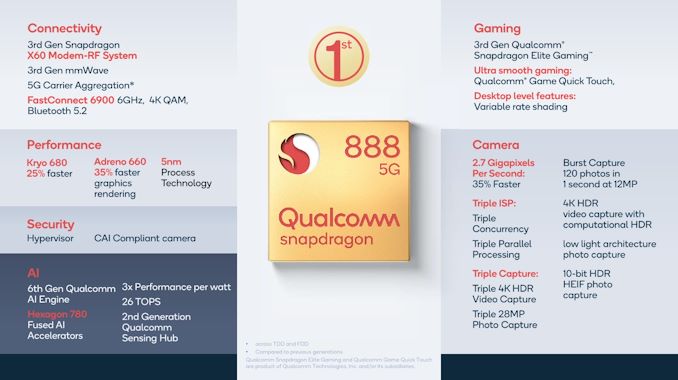Qualcomm Details The Snapdragon 888: 3rd Gen 5G & Cortex-X1 on 5nm
by Andrei Frumusanu on December 2, 2020 10:00 AM EST- Posted in
- Mobile
- Qualcomm
- Smartphones
- SoCs
- 5G
- Cortex A78
- Cortex X1
- Snapdragon 888
Conclusion & First Impressions
The new Snapdragon 888 is overall a very impressive package from Qualcomm, advancing the most important areas for which today’s smartphones are being used. 5G connectivity was the big new feature of 2020 SoCs and smartphones, and the new 888 platform represents the evolution and maturing of the new technologies that had been introduced in prior generations.
The big focus point of the Snapdragon 888 were clearly AI and cameras. The new Hexagon 780 IP block looks immensely impressive and to me seems like a major competitive advantage of the new SoC design – other vendors which aren’t as vertically integrated with their accelerator IPs will have to respond to Qualcomm’s new advancements as it seems like a major performance advantage that will be hard to mimic.
Today’s flagship smartphones have diminished ways of differentiating themselves from one another, with the cameras still being the one aspect where vendors still have very different approaches to their designs. Qualcomm’s push for a triple-ISP system in the Snapdragon 888 pushes the upper limits of what vendors will be able to do on their smartphones, allowing for a continued push for the smartphone camera ecosystem. Even for still-picture camera experiences, it seems that Qualcomm is expecting a more notable technology jump in 2021 as we see the introduction of new sensors and imaging techniques, enabled by the new SoC.
The new CPU configuration gives the new SoC a good uplift in performance, although it’s admittedly less of a jump than I had hoped for this generation of Cortex-X1 designs, and I do think Qualcomm won’t be able to retain the performance crown for this generation of Android-SoCs, with the performance gap against Apple’s SoCs also narrowing less than we had hoped for.
On the GPU side, the new 35% performance uplift is extremely impressive. If Qualcomm is really able to maintain similar power figures this generation, it should allow the Snapdragon 888 to retake the performance crown in mobile, and actually retain it for the majority of 2021.
The new Snapdragon 888 to me looks like a continuation of Qualcomm’s excellent execution over the last few years. Striking a balance between performance, power efficiency, and features is something that may be harder than it sounds, and Qualcomm’s engineering teams here seem to be focused on being able to deliver the overall best package.
Much like the Snapdragon 865, and the last couple of generations of Snapdragon SoCs before it, I expect the new Snapdragon 888 to be an excellent foundation for 2021’s flagship devices, and I’m looking forward to experience the new generation.
Related Reading:
- Qualcomm Tech Summit 2020: Day One LiveBlog (10:00 ET, 15:00 UTC)
- Qualcomm’s New 3rd Generation Snapdragon X60 5G Modem, Built on 5nm
- Qualcomm Announces Snapdragon 865+: Breaking the 3GHz Threshold
- The Snapdragon 865 Performance Preview: Setting the Stage for Flagship Android 2020
- Qualcomm Announces Snapdragon 865 and 765(G): 5G For All in 2020, All The Details
- The Snapdragon 855 Performance Preview: Setting the Stage for Flagship Android 2019
- The Qualcomm Snapdragon 855 Pre-Dive: Going Into Detail on 2019's Flagship Android SoC











123 Comments
View All Comments
Device Guru - Monday, February 1, 2021 - link
As I understand it, Band 53/n53 will make its first appearance in the 888. A great band for aggregation/5G plus it is a global band providing users with maximum flexibility.ChrisGX - Thursday, February 4, 2021 - link
While on its face going with unaltered clock rates for the SD888 compared to the previous (SD865) generation seems like the smart move because it gives a good peak performance boost of around 30% (when using the new Samsung 5LPE process) without pushing power consumption into problematic territory - reduced power consumption on the modestly clocked A78 cores should more than compensate for any increase in power consumption on the X1 core - the overall picture of power consumption for the SD888 doesn't seem to have quite worked out. Early information on the performance of the SD888 SoC in real world situations seems to indicate that while is does a great job of sustaining close to peak performance levels even when under heavy load it doesn't achieve that feat without producing troublingly elevated thermals. Many reports of engineering samples of new flagship Android smartphones becoming uncomfortably hot and suffering accelerated battery drain have recently appeared.What are we to make of this? First, it is clear that Qualcomm has tried to achieve a lot in this generation - almost everything in the SD888 has changed and the most impressive improvements are outside the CPU complex. Most notably the 5G modem is now integrated with the Snapdragon SoC and the iGPU has undergone a major upgrade. It seems that the power savings available from the 5LPE process have been insufficient to deliver the full benefit of incorporating these improved components. Qualcomm, no doubt, understood that a feature rich Snapdragon SoC was going to be essential to reassure the Android faithful that flagship Android phones were keeping pace with the iPhone. The reassurance in this case is partial. A truly compelling case for the SD888 might require an upgraded 5nm silicon process that matches the density and power savings of TSMC's N5 process. The SD888 looks to me like the right SoC in the wrong (Samsung 5LPE) silicon. Where is the 5LPP process that the SD888 (and the Exynos 2100) needs Samsung?
Indian Tech Hunter - Saturday, September 4, 2021 - link
Really want to own a Smartphone having Snapdragon 888 or even Snapdragon 888+. It is a 5nm based architecture chipset means it will be lot powerful and efficient too thats why I want smartphone having this chipset.